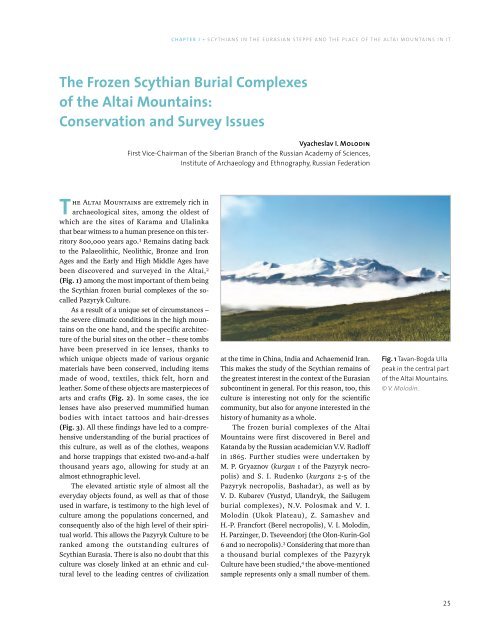Scythian Culture - Preservation of The Frozen Tombs of The Altai Mountains (UNESCO)
Create successful ePaper yourself
Turn your PDF publications into a flip-book with our unique Google optimized e-Paper software.
CHAPTER I • SCYTHIANS IN THE EURASIAN STEPPE AND THE PLACE OF THE ALTAI MOUNTAINS IN IT<br />
<strong>The</strong> <strong>Frozen</strong> <strong>Scythian</strong> Burial Complexes<br />
<strong>of</strong> the <strong>Altai</strong> <strong>Mountains</strong>:<br />
Conservation and Survey Issues<br />
Vyacheslav I. Molodin<br />
First Vice-Chairman <strong>of</strong> the Siberian Branch <strong>of</strong> the Russian Academy <strong>of</strong> Sciences,<br />
Institute <strong>of</strong> Archaeology and Ethnography, Russian Federation<br />
<strong>The</strong> <strong>Altai</strong> <strong>Mountains</strong> are extremely rich in<br />
archaeological sites, among the oldest <strong>of</strong><br />
which are the sites <strong>of</strong> Karama and Ulalinka<br />
that bear witness to a human presence on this territory<br />
800,000 years ago. 1 Remains dating back<br />
to the Palaeolithic, Neolithic, Bronze and Iron<br />
Ages and the Early and High Middle Ages have<br />
been discovered and surveyed in the <strong>Altai</strong>, 2<br />
(Fig. 1) among the most important <strong>of</strong> them being<br />
the <strong>Scythian</strong> frozen burial complexes <strong>of</strong> the socalled<br />
Pazyryk <strong>Culture</strong>.<br />
As a result <strong>of</strong> a unique set <strong>of</strong> circumstances –<br />
the severe climatic conditions in the high mountains<br />
on the one hand, and the specific architecture<br />
<strong>of</strong> the burial sites on the other – these tombs<br />
have been preserved in ice lenses, thanks to<br />
which unique objects made <strong>of</strong> various organic<br />
materials have been conserved, including items<br />
made <strong>of</strong> wood, textiles, thick felt, horn and<br />
leather. Some <strong>of</strong> these objects are masterpieces <strong>of</strong><br />
arts and crafts (Fig. 2). In some cases, the ice<br />
lenses have also preserved mummified human<br />
bodies with intact tattoos and hair-dresses<br />
(Fig. 3). All these findings have led to a comprehensive<br />
understanding <strong>of</strong> the burial practices <strong>of</strong><br />
this culture, as well as <strong>of</strong> the clothes, weapons<br />
and horse trappings that existed two-and-a-half<br />
thousand years ago, allowing for study at an<br />
almost ethnographic level.<br />
<strong>The</strong> elevated artistic style <strong>of</strong> almost all the<br />
everyday objects found, as well as that <strong>of</strong> those<br />
used in warfare, is testimony to the high level <strong>of</strong><br />
culture among the populations concerned, and<br />
consequently also <strong>of</strong> the high level <strong>of</strong> their spiritual<br />
world. This allows the Pazyryk <strong>Culture</strong> to be<br />
ranked among the outstanding cultures <strong>of</strong><br />
<strong>Scythian</strong> Eurasia. <strong>The</strong>re is also no doubt that this<br />
culture was closely linked at an ethnic and cultural<br />
level to the leading centres <strong>of</strong> civilization<br />
at the time in China, India and Achaemenid Iran.<br />
This makes the study <strong>of</strong> the <strong>Scythian</strong> remains <strong>of</strong><br />
the greatest interest in the context <strong>of</strong> the Eurasian<br />
subcontinent in general. For this reason, too, this<br />
culture is interesting not only for the scientific<br />
community, but also for anyone interested in the<br />
history <strong>of</strong> humanity as a whole.<br />
<strong>The</strong> frozen burial complexes <strong>of</strong> the <strong>Altai</strong><br />
<strong>Mountains</strong> were first discovered in Berel and<br />
Katanda by the Russian academician V.V. Radl<strong>of</strong>f<br />
in 1865. Further studies were undertaken by<br />
M. P. Gryaznov (kurgan 1 <strong>of</strong> the Pazyryk necropolis)<br />
and S. I. Rudenko (kurgans 2-5 <strong>of</strong> the<br />
Pazyryk necropolis, Bashadar), as well as by<br />
V. D. Kubarev (Yustyd, Ulandryk, the Sailugem<br />
burial complexes), N.V. Polosmak and V. I.<br />
Molodin (Ukok Plateau), Z. Samashev and<br />
H.-P. Francfort (Berel necropolis), V. I. Molodin,<br />
H. Parzinger, D. Tseveendorj (the Olon-Kurin-Gol<br />
6 and 10 necropolis). 3 Considering that more than<br />
a thousand burial complexes <strong>of</strong> the Pazyryk<br />
<strong>Culture</strong> have been studied, 4 the above-mentioned<br />
sample represents only a small number <strong>of</strong> them.<br />
Fig. 1 Tavan-Bogda Ulla<br />
peak in the central part<br />
<strong>of</strong> the <strong>Altai</strong> <strong>Mountains</strong>.<br />
© V. Molodin.<br />
25
















